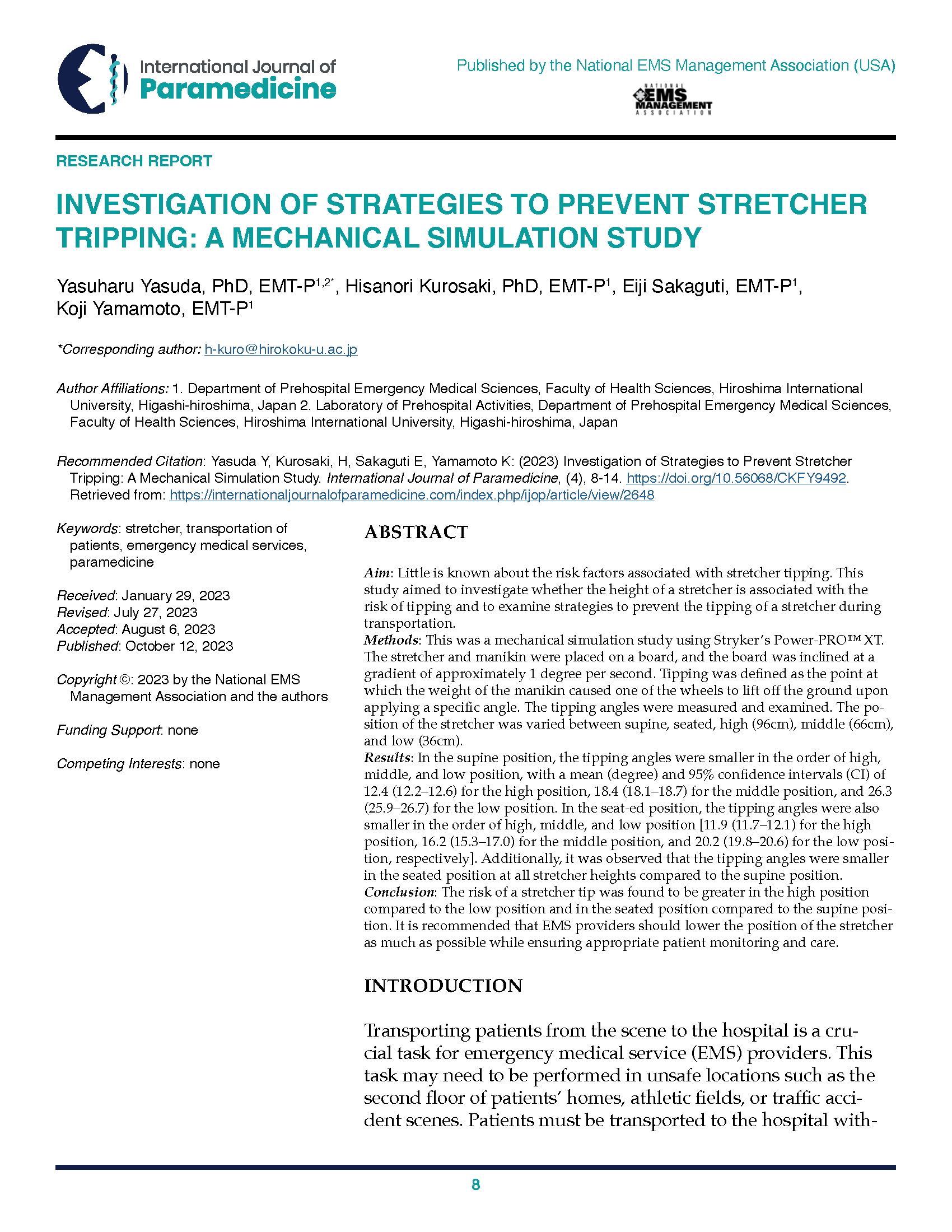Investigation of Strategies to Prevent Stretcher Tripping A Mechanical Simulation Study
Main Article Content
Abstract
Aim: The aim of this study was to investigate whether the height of a stretcher is associated with the risk of tipping, and to examine strategies to prevent the tipping of a stretcher during transportation.
Methods: This was a mechanical simulation study using Stryker’s Power-PRO™ XT. The stretcher and manikin were placed on a board and the board was inclined at a gradient of approximately 1 degree per second. Tipping was defined as the point at which the weight of the manikin caused one of the wheels to lift off the ground upon the application of a specific angle. The tipping angles were measured and examined. The position of the stretcher was varied between supine, seated, high (96cm), middle (66cm), and low (36cm).
Results: In the supine position, the tipping angles were smaller in the order of high, middle, and low position, with a mean (degree) and 95% confidence intervals (CI) of 12.4 (12.2‒12.6) for the high position, 18.4 (18.1‒18.7) for the middle position, and 26.3 (25.9‒26.7) for the low position. In the seated position, the tipping angles were also smaller in the order of high, middle, and low position [11.9 (11.7‒12.1) for the high position, 16.2 (15.3‒17.0) for the middle position, and 20.2 (19.8‒20.6) for the low position, respectively]. Additionally, it was observed that the tipping angles were smaller in the seated position at all stretcher heights, when compared to the supine position.
Conclusion: The risk of a stretcher tip was found to be greater in the high position compared to the low position, as well as in the seated position compared to the supine position. It is recommended that EMS providers should lower the position of the stretcher as much as possible while ensuring appropriate patient monitoring and care.
Article Details

This work is licensed under a Creative Commons Attribution-ShareAlike 4.0 International License.
Publishing in IJOP allows authors to keep their copyright while giving IJOP unrestricted copyright permissions. Articles published in IJOP use Creative Common Attribution 4.0 International (CC BY-ND 4.0) licensing. This license requires that re-users give credit to the creator. It allows re-users to copy and distribute the material in any medium or format in unadapted form only, even for commercial purposes. Additional terms apply and can be accessed here.
Publishing in IJOP also allows authors to have contracts for non-exclusive distribution of the Journal's published version of the article, such as posting to an institutional repository or publication in a book, on the condition that the original publication in the original layout format in IJOP is retained and acknowledged.
We permit and encourage authors to post the articles they published in IJOP on their affiliated websites. This helps share the information, encourages citation in other works, and promotes scholarly discourse in the spirit of open access.
References
Armstrong, D.P., Ferron, R., Taylor, C., McLeod, B., Fletcher, S., MacPhee, R.S., & Fischer, S.L. (2017). Implementing powered stretcher and load systems was a cost effective intervention to reduce the incidence rates of stretcher related injuries in a paramedic service. Appl Ergon, 62, 34‒42. https://doi.org/10.1016/j.apergo.2017.02.009
Fire and Disaster Management Agency. (2022). Database of EMS near-miss accidents. Ministry of Internal Affairs and Communications. Accessed from: https://internal.fdma.go.jp/hiyarihatto/
(in Japanese).
Kanda, Y. (2013). Investigation of the freely available easy-to-use software ‘EZR’ for medical statistics. Bone Marrow Transplant, 48(3), 452‒458. https://doi.org/10.1038/bmt.2012.244
Prairie, J., Plamondon, A., Larouche, D., Hegg-Deloye, S., & Corbeil, P. (2017). Paramedics' working strategies while loading a stretcher into an ambulance. Appl Ergon, 65, 112‒122. https://doi.org/10.1016/j.apergo.2017.06.005
Studnek, J.R., Crawford, J.M., & Fernandez, A.R. (2012). Evaluation of occupational injuries in an urban emergency medical services system before and after implementation of electrically powered stretchers. Appl Ergon, 43, 198‒202. https://doi.org/10.1016/j.apergo.2011.05.001
Yasuharu, Y., Kenji, I., & Yutaka, T. (2013). A study of strategies to prevent accidents during transportation (Abstract from JJESM). JJESM, 16(3), 392. Accessed from: https://mol.medicalonline.jp/library/journal/download?GoodsID=da2jjsem/2013/001603/387&name=0392-0392j&UserID=210.163.225.66/
(in Japanese).
Yutaka, T., Megumi, H., & Tetsuhito, A. (2021). Analysis of adverse events in the prehospital field activities: A quantitative study using secondary research methods. JJESM, 24(4), 569‒577. https://doi.org/10.11240/jsem.24.569
Wang, H.E., Weaver, M.D., Abo, B.N., Kaliappan, R., & Fairbanks, R.J. (2009). Ambulance stretcher adverse events. Qual Saf Health Care, 18(3), 213‒216. http://dx.doi.org/10.1136/qshc.2007.024562

